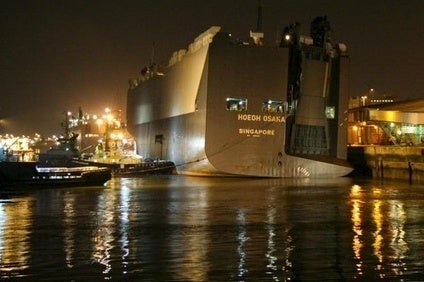So the saga of the Osaka is finally over – at least the seaborne element of it anyway – but perhaps now the real drama begins back at port in Southampton.
After salvers from Svitzer being winched on board the 51,000t vessel only to be forced to mountaineer around the car decks pitched over at more than 50°, huge storms pounding in from the Atlantic and 3,000t of seawater sloshing around after moving machinery cracked the ship side, the Hoegh Osaka has finally limped back home.
There has been a raft of acronym-heavy agencies whose expertise has collectively dragged the Hoegh Osaka from its anchored point around two miles from the Isle of Wight – and it appears they did a first-rate job.
“Working with a vessel listing at more than 50° is no simple task,” said UK Secretary of State Representative (SOSREP) for Salvage and Maritime Intervention, Hugh Shaw. “I would like to thank Her Majesty’s Coastguard Agency Centre Pollution team, the Department for Transport and the ship management who provided the crew [and insurers] Gard Norway.”
That’s just a tiny snapshot of who was involved in ensuring the ship returned to Southampton after severely listing shortly on departure nearly three weeks ago and the mosaic of agencies working so closely earned praise from Osaka owners, Hoegh Autoliners.
“I would like to draw attention to the SOSREP system in the UK,” said Hoegh Autoliners commercial director, Oyvind Ervik. “It is a rather unique system where all parties have worked with one process to save the ship, crew and cargo.

US Tariffs are shifting - will you react or anticipate?
Don’t let policy changes catch you off guard. Stay proactive with real-time data and expert analysis.
By GlobalData“It demonstrates the effectiveness of the system in the UK.”
But what now? BMW and Jaguar Land Rover are being especially twitchy as to the fate of their cars, many of which were bound for exotic Middle East destinations such as Oman, Dubai and Kuwait, with only JCB cheerfully noting it was looking to board next week to assess its 105 machines.
The car manufacturers just do not want to discuss in detail the nature of their cargo and it will be fascinating now to see how they handle the situation once the vehicles start to come off.
Intense speculation has centred around what state they will be in and whether or not they will simply be scrapped – mindful of legal and insurance implications down the line – or repaired in some way.
JLR confined itself to noting: “We are still unable to board the stricken ship so until we do, we don’t have any further update or comment,” while BMW tells me: “We will be waiting to get an indication from the ship owners of when the cars will be unloaded.”
Hoegh Autoliners tactfully used the word ‘recycled’ when it came to discussing the cars’ potential fate, although the transporter did make reference to the 2006 precedent when Mazda scrapped 4,700 vehicles after their carliner, Cougar Ace, almost capsized in 2006.
“We are aware of the Cougar Ace incident, but we are not of course privy to the thinking behind [the] decision to recycle all those cars,” said Ervik.
“There are probably technical reasons that go beyond my competence why cars can [or not] be refitted or just sold as they are or whether they have to be recycled.”
Bit by bit, anecdotal stories are starting to surface as to just how difficult the salvers’ job has been. Struggling in almost darkness and roping around the ship has unsurprisingly given some muscle strains and although the salvers were described to me as looking as if they could pick up the Hoegh Osaka in one hand, this job has been nonetheless challenging in the teeth of a freezing British winter to boot.
Pictures are bound to emerge sooner or later as to the condition of the vehicles on board at which point it will be fascinating to see whether or not the automakers will comment further and what the fate of the 1,400 cars in the Hoegh Osaka will be.
Do automakers plan for this sort of thing on a once-in-ten-year-basis or is it simply too random to factor into any long-term planning?
Whatever the outcome, it appears manufacturers can rely on the ‘system’ as Hoegh Autoliners put it to retrieve their vehicles should the totally unexpected occur.
And if it does, my money would be on the phone ringing for Svitzer.




